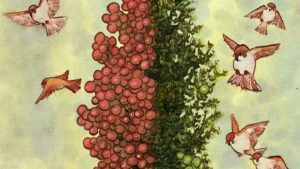How do you protect yourself from being torn apart and eaten up by dreadful insects, when you cannot hide or run? Grasses may seek help from organisms belonging to one of the lower kingdoms: Fungi! However, protection is not for free: You need to get infested by them and in return for their safeguarding the fungi will enjoy some of the delicious carbohydrates you initially prepared for yourself.
Commonly referred to as ‘endophytes’ (endo=inside, phyte =plant), these fungi belong to the genera Epichloë. Once inside, they form a life-long symbiotic relationship with their grass host and its offspring. They arm the grass host with chemical weapons, alkaloids, which are toxic to most insects. These alkaloids can be grouped into four classes: ergot alkaloids, indole-diterpenes, loline, and peramine.
From an animal point of view, it would be fair to classify the first two as the ‘bad’ bodyguard arsenal. They are the cause of ‘Ryegrass staggers’ and ‘fescue foot’; two well-known diseases observed in livestock eating grasses infected with natural endophytes.
In order to avoid such incidences, grass seed producers take great care in avoiding contamination of forage grass seed with natural endophytes during multiplication or in the following seed handling. This is specially the case in regions, where insect attack is not a major issue.
In other regions, such as the Mid-South of U.S., Australia and New Zealand, where endophyte protection is a necessary add-on, major breeding companies have screened thousands of endophytes to develop so-called “animal friendly” endophytes with no or very little ergot- or indole-diterpene production. Our company has two ryegrass- and one tall fescue specific endophytes, Happe™, Edge™, and Proteck™, respectively, which are available in several commercial forage varieties.
Peramine and loline belong to the arsenal of the good grass bodyguards as they are non-toxic to livestock, yet still retaining their insecticidal properties. Loline is believed to confer resistance towards root-eating insects because it can be transported into root tissues, although we still need more investigations to substantiate this belief.
Meanwhile, customers from an entirely different sector have become aware of the usefulness of endophytes. These are airport managers looking for means to reduce the risk of bird-strikes. The rationale is obvious: Insect resistant grass means less insects, less insects means fewer birds, fewer birds in airport areas means less collisions of birds with airplanes.
This concept, called Clearsky™, has now been adapted in several airports. So, next time your aircraft makes a successful landing, remember to look out the window for the beautiful grass fields. They came a long way from science to seeds, and today they are bodyguards for your safety.









